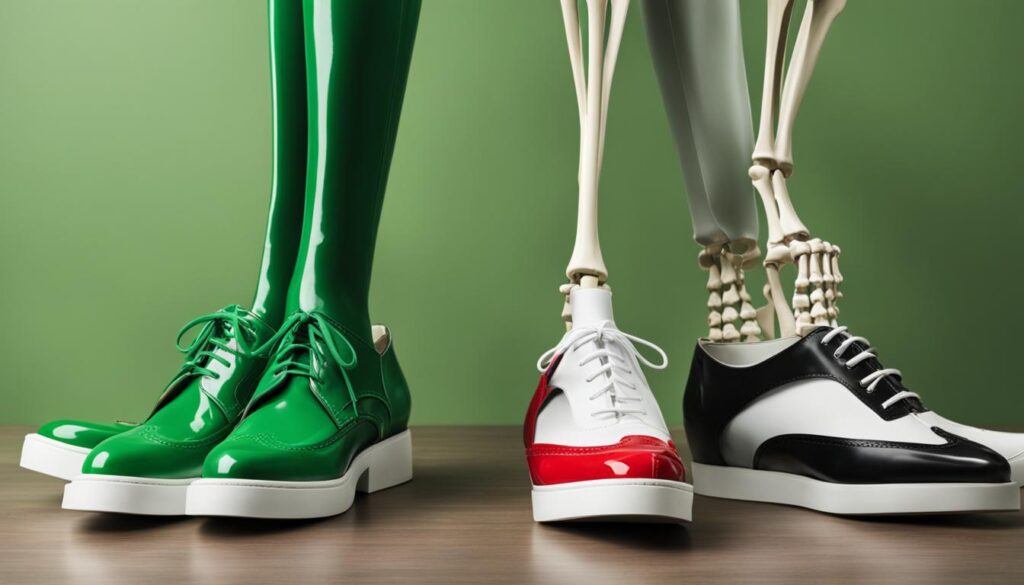Discover Effective Strategies for Hip Pain Relief Today
If you're experiencing hip pain, you're not alone. It can be a common and debilitating condition that affects many people. The good news is that there are effective strategies for hip pain relief that you can start implementing today.
One of the first strategies for hip pain relief is weight management. Carrying extra pounds can put added pressure on your hips and knees, exacerbating the pain. By losing extra weight, you can reduce the strain on your hips and potentially alleviate hip pain.
In addition to weight management, there are a variety of exercises that can help relieve hip pain. Low-impact activities such as walking, swimming, and yoga can strengthen your muscles, improve joint mobility, and reduce stiffness. These exercises are gentle on your hips while still providing the benefits of physical activity.
Hot and cold therapy is another effective strategy for hip pain relief. Applying heat, such as a hot shower or a hot water bottle, can help relax your muscles and improve circulation. Cold therapy, using an ice pack wrapped in a towel, can reduce inflammation and numb the area, providing temporary pain relief.
Choosing the right footwear is also important for hip pain relief. High heels can disrupt your body alignment and increase hip pain. Opt for flat shoes with good arch support to alleviate hip pain and distribute weight evenly across your feet and hips.
Finally, alternative therapies such as acupuncture, massage, and chiropractic care can be effective in relieving hip pain. These non-traditional methods can provide holistic relief and complement other treatment approaches.
By implementing these effective strategies for hip pain relief, you can find relief and improve your quality of life. Consult with a healthcare professional to determine the best approach for your individual needs.
Key Takeaways:
- Weight management can reduce strain on the hips and potentially alleviate hip pain.
- Low-impact exercises like walking, swimming, and yoga can strengthen muscles and improve joint mobility.
- Hot and cold therapy can provide temporary pain relief and reduce inflammation.
- Choosing the right footwear, such as flat shoes with good arch support, can alleviate hip pain.
- Alternative therapies like acupuncture, massage, and chiropractic care can be effective in relieving hip pain.
Importance of Weight Management for Hip Pain Relief
Effective weight management is crucial for relieving hip pain and improving overall joint health. Carrying excess body weight puts additional strain on the hips, exacerbating pain and inflammation. By implementing strategies to lose extra pounds, individuals can reduce the pressure on their hip joints and experience significant relief from discomfort.
The Impact of Excess Weight on Hip Joints
Carrying extra weight increases the load on the hips and knees, leading to accelerated wear and tear on the joint structures. For every 10 pounds of additional weight, there is a 50-pound increase in pressure exerted on the hips and knees. This excess pressure can aggravate existing hip pain or contribute to the development of painful conditions like osteoarthritis. Therefore, managing body weight is essential for minimizing strain on the hips and promoting long-term joint health.
Weight Loss Strategies for Hip Pain Relief
Consulting with a healthcare professional to develop a personalized weight loss plan is recommended for individuals experiencing hip pain. A comprehensive approach to weight management may include a combination of dietary changes, physical activity, and lifestyle modifications. Incorporating a balanced diet rich in nutrient-dense foods, reducing calorie intake, and practicing portion control can aid in weight loss. Additionally, engaging in low-impact exercises, such as swimming or yoga, can provide cardiovascular benefits and help burn calories without placing excessive stress on the joints.
Furthermore, it is important to consider the weight of items regularly carried, such as groceries or bags. Using a handcart for heavy loads and opting for backpack-style bags can distribute weight more evenly and alleviate strain on the hips. By implementing these weight management strategies, individuals can significantly reduce hip pain, enhance mobility, and improve overall quality of life.
Low-Impact Exercises for Hip Pain Relief
When it comes to managing hip pain, incorporating low-impact exercises into your routine can be highly beneficial. These exercises are gentle on the joints while still helping to strengthen muscles, improve joint mobility, and reduce stiffness. Let's explore some low-impact exercises that are particularly effective for providing hip pain relief:
Walking
Walking is a simple yet effective low-impact exercise that can be easily incorporated into your daily routine. It helps to improve cardiovascular health, strengthen the lower body muscles, and increase overall joint flexibility. Start with shorter walks and gradually increase the duration as your endurance improves. Remember to wear comfortable shoes with good arch support to ensure proper alignment and minimize stress on the hips.
Swimming
Swimming is another excellent low-impact exercise for hip pain relief. The buoyancy of water helps relieve pressure on the joints, making it an ideal choice for individuals with hip pain. Swimming engages multiple muscle groups, including the hips, without putting excessive strain on the joints. Consider incorporating different strokes, such as freestyle, backstroke, and breaststroke, to target different muscle groups and maximize the benefits.
Yoga
Yoga is a gentle form of exercise that focuses on stretching, strengthening, and balancing the body. It can help improve flexibility, build muscle strength, and promote relaxation and stress reduction. Specific yoga poses, such as the Bridge pose, Pigeon pose, and Supine Spinal Twist, can provide targeted relief for hip pain. Always listen to your body and modify poses as needed to avoid any discomfort or pain.
Table: Comparison of Low-Impact Exercises for Hip Pain Relief
| Exercise | Benefits | Tips |
|---|---|---|
| Walking | Improves cardiovascular health, strengthens lower body muscles, and increases joint flexibility. | Start with shorter walks and gradually increase duration. Wear comfortable shoes with good arch support. |
| Swimming | Relieves pressure on joints, engages multiple muscle groups, and provides overall body conditioning. | Choose different swimming strokes to target different muscle groups. Consider using pool noodles or flotation devices for added support. |
| Yoga | Improves flexibility, builds muscle strength, and promotes relaxation and stress reduction. | Listen to your body and modify poses as needed. Practice under the guidance of a qualified instructor. |

These low-impact exercises can be highly effective in providing relief from hip pain. However, it's important to consult with a healthcare professional or physical therapist before starting any new exercise program, especially if you have pre-existing conditions or injuries. They can provide personalized recommendations and guide you in developing a safe and effective exercise routine tailored to your specific needs.
By incorporating low-impact exercises into your daily routine, you can strengthen your muscles, improve joint mobility, and reduce hip pain, ultimately enhancing your overall well-being and quality of life.
Specific Exercises for Hip Pain Relief
When it comes to relieving hip pain, incorporating specific exercises that target the muscles supporting the hip joints can make a significant difference. Working with a physical therapist is highly recommended to ensure proper form and technique, as well as to avoid any potential injuries. Here are some examples of exercises that can help alleviate hip pain:
Core Exercises
Strengthening the core muscles can provide stability and support to the hips, reducing pain and discomfort. Incorporate exercises like planks, bridges, and abdominal crunches into your routine to target the muscles in your abdomen, lower back, and pelvis.
Leg Exercises
Exercises that focus on the muscles in the legs, such as squats, lunges, and leg presses, can also help alleviate hip pain. These exercises help improve the overall strength and flexibility of the leg muscles, providing better support to the hip joints.
Remember to listen to your body and stop any exercise if you experience pain. Start with low intensity and gradually increase the difficulty as your body gets stronger. Gentle stretching exercises can also be beneficial in loosening up tight muscles and relieving hip pain.
Working with a physical therapist will provide you with a customized exercise plan tailored to your specific needs and abilities. They can guide you through proper technique and progression, ensuring that you are safely and effectively working towards hip pain relief.
Hot and Cold Therapy for Hip Pain Relief
Hot and cold therapy can be a highly effective method for relieving hip pain. By utilizing temperature variations, this therapy can help reduce inflammation and promote muscle relaxation, ultimately providing relief from discomfort. When it comes to managing hip pain through hot and cold therapy, it is important to understand the benefits of both heat and cold applications.
Applying heat to the affected area, such as using a hot shower or a hot water bottle, can help relax the muscles and improve blood circulation. This increased blood flow can aid in reducing stiffness and promoting healing. On the other hand, cold therapy, which involves using an ice pack wrapped in a towel, can help reduce inflammation and numb the area, providing temporary pain relief.
“Hot and cold therapy can alleviate hip pain by reducing inflammation and promoting muscle relaxation.”
One effective approach is to alternate between hot and cold therapy. This can help to further reduce inflammation and promote muscle relaxation, ultimately providing greater pain relief. However, it is important to exercise caution when using hot or cold therapy, especially in the presence of any underlying conditions or injuries.
| Benefits of Hot Therapy | Benefits of Cold Therapy |
|---|---|
| Relaxes muscles | Reduces inflammation |
| Improves blood circulation | Numbs the area |
| Reduces stiffness | Provides temporary pain relief |
Hot and cold therapy can be a valuable tool in managing hip pain. However, it is important to consult with a healthcare professional to determine the most suitable approach for individual circumstances. By utilizing hot and cold therapy effectively, individuals can experience relief from hip pain and improve their overall quality of life.
Footwear and Body Alignment for Hip Pain Relief
When it comes to hip pain relief, one crucial factor to consider is the type of footwear worn. Wearing high heels can put the foot at an unnatural angle, disrupting body alignment and potentially leading to hip pain. It is advisable to opt for flat shoes with good arch support and cushioning to alleviate hip discomfort. Proper footwear provides the necessary support and helps distribute weight evenly across the feet and hips, reducing strain on the joints.
Additionally, it is essential to avoid standing for extended periods without taking breaks and shifting weight between feet. By maintaining proper body alignment and posture, individuals can reduce strain on their hips and find relief from pain. Choosing shoes that provide the right support and considering how weight is distributed throughout the body can make a significant difference in managing hip pain.
“The type of footwear worn can impact hip pain. High heels can put the foot at an unnatural angle and disrupt body alignment, leading to hip pain.”
By paying attention to footwear choices and prioritizing body alignment, individuals can effectively alleviate hip pain and improve their overall comfort and mobility. It is worthwhile to consult with a healthcare professional or a podiatrist to ensure proper shoe selection for individual needs and foot conditions.

Medications for Hip Pain Relief
When it comes to finding relief from hip pain, medications can be an effective option. Non-steroidal anti-inflammatory drugs (NSAIDs) such as ibuprofen and naproxen can help reduce inflammation and provide pain relief. These medications work by blocking the production of certain chemicals that cause pain and swelling in the body. Acetaminophen is another medication commonly used for hip pain relief, especially if NSAIDs are not suitable for an individual.
Before starting any medication regimen for hip pain relief, it is important to consult with a healthcare professional. They can determine the appropriate type and dosage of medication based on the individual's specific needs and medical history. In some cases, stronger medications may be prescribed if the pain is severe or persistent.
It is important to note that while medications can provide temporary relief, they do not address the underlying cause of the hip pain. Therefore, it is often recommended to combine medication with other treatment methods, such as exercise, physical therapy, and lifestyle changes, to achieve optimal pain management and long-term relief.
| Medication Type | Examples | How It Works | Possible Side Effects |
|---|---|---|---|
| Non-steroidal Anti-inflammatory Drugs (NSAIDs) | Ibuprofen, Naproxen | Reduce inflammation and provide pain relief by blocking certain chemicals in the body | Stomach upset, gastrointestinal bleeding, increased risk of heart attack or stroke with prolonged use |
| Acetaminophen | Tylenol | Helps alleviate pain, but does not have anti-inflammatory properties | Liver damage with high doses or long-term use |
It is important to use medications as directed by a healthcare professional and follow the recommended dosage guidelines. If the pain persists or worsens despite medication use, it is essential to seek further medical evaluation to determine the underlying cause of the hip pain and explore additional treatment options.
Expert Tip:
“Medications can provide temporary relief from hip pain, but it's important to address the underlying cause of the pain. Combining medications with other treatment methods, such as exercise and lifestyle changes, can help achieve long-term pain management and improved quality of life.” – Dr. Jane Johnson, Orthopedic Specialist
Alternative Therapies for Hip Pain Relief
When it comes to finding relief from hip pain, alternative therapies offer promising options. These non-traditional methods can complement conventional treatments and provide holistic approaches to managing and alleviating hip pain. Alternative therapies such as acupuncture, massage therapy, and chiropractic adjustments have shown effectiveness in reducing hip pain and improving overall quality of life.
Acupuncture: This ancient Chinese practice involves the insertion of thin needles into specific points on the body. Acupuncture is believed to stimulate the body's natural healing processes and promote pain relief. By targeting specific meridian points, acupuncture can help alleviate hip pain and restore balance to the body.
Massage Therapy: Massage therapy offers a hands-on approach to hip pain relief. Through various techniques such as Swedish massage, deep tissue massage, and trigger point therapy, massage therapists can alleviate muscle tension, reduce inflammation, and promote relaxation. Regular massage sessions can help improve circulation, flexibility, and overall hip joint mobility.
Chiropractic Adjustments: Chiropractic care focuses on the alignment of the spine and its impact on the body's overall health. Misalignments in the spine can contribute to hip pain and discomfort. Chiropractors use manual adjustments to correct spinal misalignments and improve joint mobility. By addressing the root cause of hip pain, chiropractic adjustments can provide long-term relief and improve hip function.
| Alternative Therapy | Benefits |
|---|---|
| Acupuncture | Pain relief, restoration of balance |
| Massage Therapy | Reduced muscle tension, improved circulation |
| Chiropractic Adjustments | Improved spinal alignment, enhanced joint mobility |
Alternative therapies provide a natural and drug-free approach to relieving hip pain. While individual results may vary, many individuals have found significant relief and improved hip function through these methods. It is important to consult with qualified practitioners and healthcare professionals to determine the most suitable alternative therapies for individual needs and conditions.
Importance of Sleep and Rest for Hip Pain Relief
Adequate sleep and rest are crucial factors in relieving hip pain. Resting the affected hip joint allows for proper healing and reduces inflammation. Additionally, finding the right sleep position can provide significant relief. Placing a pillow between the legs while sleeping on the back or side can provide support and alignment for the hips, reducing pain and discomfort. It is essential to listen to your body and avoid positions that cause discomfort or exacerbate hip pain.
Sleep and rest are not only important for physical recovery but also for overall well-being. Lack of sleep can increase stress levels and exacerbate pain perception. By prioritizing sleep and allowing the body to rest, individuals can promote healing and alleviate hip pain.
“A good night's sleep can do wonders for hip pain relief. By finding a comfortable sleep position and providing proper support to the hip joint, you can wake up feeling refreshed and with reduced pain.”
In addition to proper sleep positions, creating a conducive sleep environment can also contribute to hip pain relief. Ensure that your mattress and pillows provide adequate support for your body, especially the hips. Investing in quality bedding can go a long way in promoting comfortable and pain-free sleep.
| Benefit of Sleep and Rest for Hip Pain Relief | Description |
|---|---|
| Reduced inflammation | Proper rest allows the body to heal and reduces inflammation in the hip joints, leading to pain relief. |
| Improved pain tolerance | Adequate sleep can help regulate pain perception, making it easier to manage and cope with hip pain. |
| Enhanced healing | Resting the affected hip joint promotes tissue repair and accelerates the healing process. |
| Reduced stress levels | Quality sleep and rest contribute to overall stress reduction, which can positively impact hip pain management. |
Importance of Lifestyle Changes for Hip Pain Relief
When it comes to managing hip pain, making lifestyle changes is crucial. These changes not only provide relief from hip pain but also contribute to overall well-being. One of the key aspects of lifestyle changes is weight management. By maintaining a healthy weight, you can reduce strain on the hip joints and alleviate pain. Incorporating regular exercise, such as low-impact activities like walking and swimming, helps strengthen the supporting muscles and improves joint flexibility. Avoiding high-impact activities and wearing proper footwear, such as flat shoes with good arch support, further reduces strain on the hips.
Implementing ergonomic habits in your daily routine can also make a significant difference. For example, using a handcart for heavy objects instead of carrying them in your hands can decrease pressure on the hips. Additionally, taking breaks and shifting weight between feet when standing for extended periods can help maintain proper body alignment and reduce strain on the hips.
These lifestyle changes should be integrated holistically to achieve optimal results. By adopting a comprehensive approach that includes weight management, regular exercise, proper footwear, and ergonomic habits, you can effectively manage hip pain and improve your quality of life.
The Benefits of Lifestyle Changes for Hip Pain Relief
- Reduce strain on hip joints
- Alleviate pain and discomfort
- Improve joint flexibility and stability
- Promote proper body alignment
- Enhance overall well-being
Implementing lifestyle changes in conjunction with other hip pain relief strategies can yield significant results. By taking proactive steps to manage your hip pain, you can experience long-lasting relief and improve your overall quality of life.
Importance of Listening to the Body for Hip Pain Relief
When it comes to managing hip pain, one of the most important factors to consider is listening to your body. While exercise and physical activity can be beneficial in alleviating pain, it's crucial to recognize your limits and avoid excessive strain. Pain management requires a balance between pushing yourself to improve and avoiding activities that may cause further injury or discomfort.
Feeling soreness the day after exercising is normal, as it indicates your muscles are working. However, if you experience persistent or worsening pain, it's essential to address it promptly. Sharp or shooting pain during exercise is a sign to immediately stop the activity and consult a healthcare professional. Ignoring these signals can exacerbate the pain and delay the healing process.
By paying attention to your body, you can effectively manage hip pain and prevent further complications. This involves understanding your pain threshold, recognizing the difference between muscle soreness and actual pain, and adjusting your activities accordingly. Remember, pain is your body's way of communicating, and it's crucial to listen and respond appropriately for optimal hip pain relief.
Avoiding Excessive Strain: Tips to Listen to Your Body
- Start slowly: If you're just beginning an exercise routine, practice moderation and gradually increase intensity and duration over time.
- Warm up: Always warm up before engaging in any physical activity to prepare your muscles and joints.
- Pay attention to form: Proper form is essential to prevent unnecessary strain on your hips. Seek guidance from a professional if needed.
- Take rest days: Allow your body time to recover and repair. Rest days are just as important as active days.
- Use pain as a guide: If an activity causes pain, modify or find an alternative exercise that works for you.
- Consult a healthcare professional: If you're unsure about a specific exercise or activity, seeking guidance from a healthcare professional can provide valuable insight and prevent potential injuries.
By incorporating these tips and actively listening to your body, you can effectively manage hip pain and maintain a healthy, active lifestyle. Remember, your body knows best, and by giving it the attention and care it deserves, you can achieve long-term hip pain relief.
Conclusion
In conclusion, when it comes to managing hip pain, it is essential to implement effective strategies that address the root causes and provide relief. By combining various approaches, we can achieve holistic relief and improve our overall quality of life.
One of the key strategies for hip pain relief is weight management. By reducing excess body weight, we can alleviate strain on the hip joints and potentially reduce pain. Incorporating low-impact exercises such as walking, swimming, and yoga can also help strengthen muscles, improve joint mobility, and reduce stiffness.
In addition to exercise, utilizing hot and cold therapy can provide temporary pain relief. Alternating between heat and cold can reduce inflammation and promote muscle relaxation. It is important to choose appropriate footwear that supports proper body alignment and avoids unnecessary strain on the hips.
Furthermore, medications and alternative therapies such as acupuncture, massage, and chiropractic adjustments can be effective pain management techniques. By listening to our bodies and recognizing our limits, we can prevent further injury and effectively manage hip pain.
By adopting a comprehensive and holistic approach to hip pain relief, we can find effective strategies that work for us and improve our overall well-being. By addressing the causes and implementing lifestyle changes, we can achieve long-term relief and better manage hip pain in our daily lives.
FAQ
What are some effective strategies for hip pain relief?
Effective strategies for hip pain relief include weight management, low-impact exercises, hot and cold therapy, specific exercises targeting the hip muscles, wearing proper footwear, using medications such as NSAIDs, exploring alternative therapies like acupuncture and massage, prioritizing sleep and rest, making lifestyle changes, and listening to the body.
How important is weight management for hip pain relief?
Weight management is crucial for hip pain relief. Carrying extra body weight puts additional pressure on the hips and knees. Losing extra pounds can reduce strain on the hips and potentially alleviate hip pain. Using a handcart for groceries and choosing luggage with wheels can help lighten the load on the hips.
Which low-impact exercises can help with hip pain relief?
Low-impact exercises like walking, swimming, and yoga are recommended for managing hip pain. These exercises help strengthen muscles, improve joint mobility, and reduce stiffness. Water exercises in a pool or spa provide additional support to the body and help strengthen muscles without causing excessive strain on the hips.
What specific exercises can provide hip pain relief?
Working with a physical therapist, you can develop a customized exercise routine targeting the muscles that support the hip joints. Core exercises, leg exercises, and exercises that strengthen the muscles around the hip joints are beneficial for hip pain relief. It is important to listen to the body and stop a workout if pain is felt. Gentle stretching exercises can also help alleviate hip pain by loosening up muscles.
How can hot and cold therapy help with hip pain relief?
Applying heat, such as a hot shower or hot water bottle, can help relax muscles and improve circulation, providing temporary pain relief. Cold therapy, using an ice pack wrapped in a towel, can reduce inflammation and numb the area, providing temporary pain relief as well. Alternating between hot and cold therapy can help alleviate hip pain by reducing inflammation and promoting muscle relaxation.
How does footwear and body alignment impact hip pain relief?
Wearing high heels can put the foot at an unnatural angle and disrupt body alignment, leading to hip pain. Opting for flat shoes with good arch support and cushioning can help alleviate hip pain. It is important to choose shoes that provide proper support and distribute weight evenly across the feet and hips. Avoiding standing for extended periods of time without taking breaks and shifting weight between feet can also help reduce strain on the hips.
What medications can provide hip pain relief?
Non-steroidal anti-inflammatory drugs (NSAIDs) such as ibuprofen and naproxen can reduce inflammation and provide pain relief. Acetaminophen can also be used to alleviate pain if NSAIDs are not suitable. It is important to consult a doctor to determine the appropriate type and dosage of medication for individual needs. Depending on the cause and severity of hip pain, stronger medications may be prescribed.
Can alternative therapies help with hip pain relief?
Yes, alternative therapies like acupuncture, massage therapy, and chiropractic adjustments may also be effective in relieving hip pain. Acupuncture involves inserting thin needles into specific points on the body to relieve pain. Massage therapy increases circulation, reduces inflammation, and promotes muscle relaxation. Chiropractic adjustments aim to align the spine and improve mobility, which can have a positive effect on hip pain. These alternative therapies can be used in combination with other treatment methods for holistic hip pain relief.
How important is sleep and rest for hip pain relief?
Adequate sleep and rest are important for hip pain relief. Resting the affected hip joint helps alleviate pain and reduce inflammation. Proper sleep positions, such as placing a pillow between the legs while sleeping on the back or side, can provide support and alignment for the hips. Finding a comfortable sleep position and providing proper support to the hip joint can promote healing and relieve pain.
How can lifestyle changes contribute to hip pain relief?
Making lifestyle changes such as maintaining a healthy weight, engaging in regular exercise, avoiding high-impact activities, wearing proper footwear, and implementing ergonomic habits can contribute to hip pain relief. These changes reduce strain on the hip joints and improve overall hip health, resulting in pain reduction and improved quality of life.
Why is listening to the body important for hip pain relief?
Listening to the body is crucial when managing hip pain. Engaging in exercise and physical activity can help alleviate pain but it is important to recognize the limits and avoid excessive strain. Sharp or shooting pain is a sign to immediately stop the activity and consult a healthcare professional. By listening to the body and understanding its limits, individuals can effectively manage hip pain and prevent further injury.
What are some holistic approaches to hip pain relief?
Holistic approaches to hip pain relief include weight management, regular exercise, hot and cold therapy, specific exercises targeting the hip muscles, wearing proper footwear, exploring alternative therapies, ensuring adequate sleep and rest, making lifestyle changes, and listening to the body. By implementing these effective strategies and adopting a holistic approach, individuals can find relief from hip pain and improve their overall quality of life.
Source Links
- https://spokanespineteam.com/what-is-the-fastest-way-to-relieve-hip-pain/
- https://www.webmd.com/arthritis/ss/slideshow-ease-hip-pain
- https://www.everydayhealth.com/hip-pain/ways-to-relieve-hip-pain/











Leave a Reply